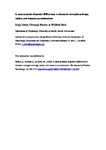A meta-analysis of gender differences in character strengths and age, nation, and measure as moderators
| dc.contributor.author | Heintz, Sonja | |
| dc.contributor.author | Kramm, C | |
| dc.contributor.author | Ruch, W | |
| dc.date.accessioned | 2020-04-06T17:00:52Z | |
| dc.date.available | 2020-04-06T17:00:52Z | |
| dc.date.issued | 2019-01-02 | |
| dc.identifier.issn | 1743-9760 | |
| dc.identifier.issn | 1743-9779 | |
| dc.identifier.uri | http://hdl.handle.net/10026.1/15508 | |
| dc.description.abstract |
The present meta-analysis investigates gender differences in the 24 VIA character strengths. Based on a literature search on quantitative studies that assessed character strengths, 65 samples consisting of both published and unpublished data were included (total N = 1,189,924). A random-effects model yielded significant gender differences for 17 of the 24 character strengths, although only four of these differences showed at least small effects: Females scored higher than males in appreciation of beauty and excellence, kindness, love, and gratitude. Thus, males and females were mostly similar in their character strengths. The size of the gender differences did not vary with nationality (i.e. the US, Switzerland, Germany, and Israel), while age and type of measure were significant moderators for 13-14 character strengths. The most pronounced differences emerged between children/adolescents and the VIA-Youth in comparison to adults and the VIA-IS as well as the short measures. | |
| dc.format.extent | 103-112 | |
| dc.language | en | |
| dc.language.iso | en | |
| dc.publisher | Informa UK Limited | |
| dc.subject | Character strengths | |
| dc.subject | VIA-IS (Values in Action Inventory) | |
| dc.subject | meta-analysis | |
| dc.subject | gender differences | |
| dc.title | A meta-analysis of gender differences in character strengths and age, nation, and measure as moderators | |
| dc.type | journal-article | |
| dc.type | Journal Article | |
| plymouth.author-url | https://www.webofscience.com/api/gateway?GWVersion=2&SrcApp=PARTNER_APP&SrcAuth=LinksAMR&KeyUT=WOS:000452778400013&DestLinkType=FullRecord&DestApp=ALL_WOS&UsrCustomerID=11bb513d99f797142bcfeffcc58ea008 | |
| plymouth.issue | 1 | |
| plymouth.volume | 14 | |
| plymouth.publication-status | Published | |
| plymouth.journal | The Journal of Positive Psychology | |
| dc.identifier.doi | 10.1080/17439760.2017.1414297 | |
| plymouth.organisational-group | /Plymouth | |
| plymouth.organisational-group | /Plymouth/Faculty of Health | |
| plymouth.organisational-group | /Plymouth/Faculty of Health/School of Psychology | |
| plymouth.organisational-group | /Plymouth/REF 2021 Researchers by UoA | |
| plymouth.organisational-group | /Plymouth/REF 2021 Researchers by UoA/UoA04 Psychology, Psychiatry and Neuroscience | |
| plymouth.organisational-group | /Plymouth/REF 2021 Researchers by UoA/UoA04 Psychology, Psychiatry and Neuroscience/UoA04 Psychology, Psychiatry and Neuroscience MANUAL | |
| plymouth.organisational-group | /Plymouth/Research Groups | |
| plymouth.organisational-group | /Plymouth/Research Groups/Plymouth Institute of Health and Care Research (PIHR) | |
| plymouth.organisational-group | /Plymouth/Users by role | |
| plymouth.organisational-group | /Plymouth/Users by role/Academics | |
| dcterms.dateAccepted | 2017-11-15 | |
| dc.identifier.eissn | 1743-9779 | |
| dc.rights.embargoperiod | Not known | |
| rioxxterms.versionofrecord | 10.1080/17439760.2017.1414297 | |
| rioxxterms.licenseref.uri | http://www.rioxx.net/licenses/all-rights-reserved | |
| rioxxterms.licenseref.startdate | 2019-01-02 | |
| rioxxterms.type | Journal Article/Review |


